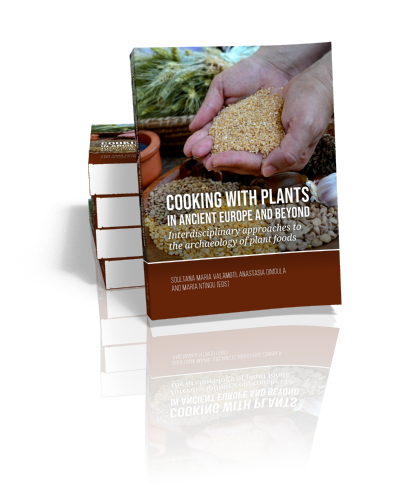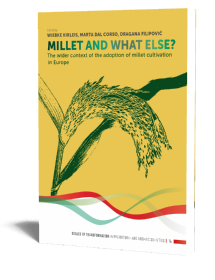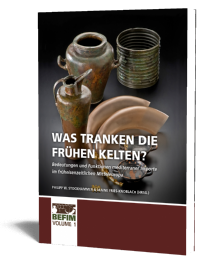Cooking with plants in ancient Europe and beyond
Interdisciplinary approaches to the archaeology of plant foods
Edited by Soultana Maria Valamoti, Anastasia Dimoula & Maria Ntinou | 2022

Cooking with plants in ancient Europe and beyond
Interdisciplinary approaches to the archaeology of plant foods
Edited by Soultana Maria Valamoti, Anastasia Dimoula & Maria Ntinou | 2022
Paperback ISBN: 9789464270334 | Hardback ISBN: 9789464270341 | Imprint: Sidestone Press Academics | Format: 210x280mm | 530 pp. | Language: English | 29 illus. (bw) | 207 illus. (fc) | Keywords: ancient cuisine; archaeobotany; petrographic analysis; usewear analysis; food remains; cooking facilities; prehistory; edible plants; modern landraces; experimental archaeology; ethnoarchaeology | download cover
Read online or downloaded 3594 times
-
Digital & Online access
This is a full Open Access publication, click below to buy in print, browse, or download for free.
-
Buy via Sidestone (EU & UK)
-
Buy via our Distributors (WORLD)
For non-EU or UK destinations you can buy our books via our international distributors. Although prices may vary this will ensure speedy delivery and reduction in shipping costs or import tax. But you can also order with us directly via the module above.
UK international distributor
USA international distributor
-
Bookinfo
Paperback ISBN: 9789464270334 | Hardback ISBN: 9789464270341 | Imprint: Sidestone Press Academics | Format: 210x280mm | 530 pp. | Language: English | 29 illus. (bw) | 207 illus. (fc) | Keywords: ancient cuisine; archaeobotany; petrographic analysis; usewear analysis; food remains; cooking facilities; prehistory; edible plants; modern landraces; experimental archaeology; ethnoarchaeology | download cover
Read online or downloaded 3594 times

We will plant a tree for each order containing a paperback or hardback book via OneTreePlanted.org.
Plants have constituted the basis of human subsistence. This volume focuses on plant food ingredients that were consumed by the members of past societies and on the ways these ingredients were transformed into food. The thirty chapters of this book unfold the story of culinary transformation of cereals, pulses as well as of a wide range of wild and cultivated edible plants.
Regional syntheses provide insights on plant species choices and changes over time and fragments of recipes locked inside amorphous charred masses. Grinding equipment, cooking installations and cooking pots are used to reveal the ancient cooking steps in order to pull together the pieces of a culinary puzzle of the past. From the big picture of spatiotemporal patterns and changes to the micro-imaging of usewear on grinding tool surfaces, the book attempts for the first time a comprehensive and systematic approach to ancient plant food culinary transformation.
Focusing mainly on Europe and the Mediterranean world in prehistory, the book expands to other regions such as South Asia and Latin America and covers a time span from the Palaeolithic to the historic periods. Several of the contributions stem from original research conducted in the context of ERC project PlantCult: Investigating the Plant Food Cultures of Ancient Europe. The book’s exploration into ancient cuisines culminates with an investigation of the significance of ethnoarchaeology towards a better understanding of past foodways as well as of the impact of archaeology in shaping modern culinary and consumer trends.
The book will be of interest to archaeologists, food historians, agronomists, botanists as well as the wider public with an interest in ancient cooking.
Introduction: Cooking with Plants in Ancient Europe and Beyond
Soultana Maria Valamoti, Anastasia Dimoula, Maria Ntinou
Plant ingredients archived with ArboDat – evaluating regional food preferences and changes from crop remains, using the new archaeobotanical database for Greece
Soultana Maria Valamoti, Angela Kreuz, Chryssa Petridou, Angeliki Karathanou, Martha Kokkidou, Pavlos Lathiras, Stavroula Michou, Pelagia Paraskevopoulou, Hara Stylianakou
Cooking with cereals in the Early Bronze Age kitchens of Archondiko Giannitson (Northern Greece): an archaeobotanical investigation of phase IV (2135-2020 cal BC)
Soultana Maria Valamoti, Chryssi Petridou
Early viticulture in Neolithic and Bronze Age Greece: looking for the best traditional morphometric method to distinguish wild and domestic grape pips
Vincent Bonhomme, Clémence Pagnoux, Laurent Bouby, Sarah Ivorra, Susan E. Allen, Soultana Maria Valamoti
Land management and food resources in Bronze Age Central Greece. Insights from archaeobotanical assemblages from the sites of Agia Paraskevi, Kynos and Mitrou (Phthiotida)
Maria Ntinou, Angeliki Karathanou, Clemence Pagnoux, Soultana-Maria Valamoti
Staple grains in the later Bronze Age of the (southern) Aegean: archaeobotanical, textual and ethnographic insights
Paul Halstead, Amy Bogaard, Glynis Jones
Early Chalcolithic plant economy at Aktopraklık Höyük in northwest Anatolia: preliminary findings
Ceren Kabukcu, Eleni Asouti, Emma Percival, Ellen Grice, Necmi Karul
New bioarchaeological approaches to the study of plant food practices in the Eastern Mediterranean during the 2nd millennium BC
Janine Fries-Knoblach and Philipp W. Stockhammer
The importance of flavoured food: a (cautious) consideration of spices and herbs in Indus Civilization (ca 3200-1500 BC) recipes
Jennifer Bates
The first five millennia of plant food production in the central and western Balkans: archaeobotanical evidence from the Neolithic to the Bronze Age
Dragana Filipović, Djurdja Obradović, Anne de Vareilles
Strategic drinking: The shelf-life and socio-political importance of Early Iron Age west-central European beer
Joshua Driscoll
Cereals and cereal-based products from Tiel Medel, an Early Neolithic Swifterbant site in the Netherlands
Lucy Kubiak-Martens
Cooked and raw. Fruits and seeds in the Iberian Palaeolithic
Ernestina Badal, Carmen M. Martínez Varea
Trends and evolution of the plant-based diet in prehistoric Iberia: a view from archaeobotany
Leonor Peña-Chocarro, Guillem Pérez-Jordà
Unearthing a new food culture: fruits in early modern Ireland
Meriel McClatchie, Susan Flavin, Ellen OCarroll
Let nothing go hungry: The indigenous worldview of Andean food and feeding
Christine A. Hastorf
Grinding and pounding in Early Neolithic Southeastern Europe: culinary preferences and social dimensions of plantfood processing
Ismini Ninou, Nikos Efstratiou, Soultana-Maria Valamoti
Grinding practices in prehistoric north and central Greece: evidence from the use-wear analysis
Danai Chondrou, Maria Bofill, Haris Procopiou, RobertoVargiolu, Hassan Zahouani, Eleftheria Almasidou, Tasos Bekiaris, Ismini Ninou, Soultana Maria Valamoti
The daily grind. Investigating the contexts of food grinding practices and tools in the Neolithic of Southeastern Europe
Tasos Bekiaris, Danai Chondrou, Ismini Ninou, Soultana-Maria Valamoti
Cooking on the rocks? An interdisciplinary approach on the use of burnt stone slabs from Neolithic Avgi, Kastoria
Tasos Bekiaris, Nikos Katsikaridis, Christos L. Stergiou, Georgia Stratouli
Grinding systems as cultural markers at the turn of the 6th millennium BC in north-western continental Europe
Caroline Hamon
Cooking in progress: Evolution and diversity of cooking pottery in prehistoric Northern Greece and Bulgaria
Anastasia Dimoula, Zoi Tsirtsoni, Paraskevi Yiouni, Alexander Chohadzhiev, Pascal Darcque, Maria Ivanova, Chaido Koukouli-Chryssanthaki, Sofia Koulidou, Krassimir Leshtakov, Petar Leshtakov, Konstantinos Filis, Dimitria Malamidou, Nikos Merousis, Aikaterini Papanthimou, Vanya Petrova, Evangelia Stefani†, Nadezhda Todorova, Katerina Tzanavari, Evangelia Voulgari, Soultana Maria Valamoti
Plant boiling among the first pottery-making societies in the southern levant: an insight from carbonized residues of pottery
Julien Vieugué, Monica Ramsey, Yosef Garfinkel
Cooking in Bronze Age northern Greece: an investigation of thermal structures
Evanthia Papadopoulou, Sandra Prévost-Dermarkar, Anastasia Dimoula, Niki Chondrou, Soultana-Maria Valamoti
Clay Cooking Ware and Kitchen Equipment in the Ancient Greek Household
Eleni Manakidou
Preparing Vegetables in Ceramic Pots Over a Hearth Fire: Using Minoan Cookware to Understand Plant-based Dishes in the Ancient World
Jerolyn E. Morrison
Glume wheats in modern Greece: lessons for antiquity
Paul Halstead
Modern research and efforts for the organic restoration of prehistoric wheat in Greece
Kostas Koutis, Evangelos Korpetis, Parthenopi E. Ralli, Nikolaos Stavropoulos†
Acorns as an Alternative Vital Food Resource Today: an example from Kea island, Greece
Marcie Mayer
Food plants and commensality among early farmers in the Iberian Peninsula: connecting pioneering and modern kitchens
Anna B. Barberà, Sandra Lozano, Ferran Adrià, Ramon Buxó, Antoni Palomo
“If You Brew It, They Will Come”: Experimental Archaeology, Ancient Alcohol and US Museums
Bettina Arnold
Prof. dr. Soultana Maria Valamoti
Soultana Maria Valamoti is Professor of Prehistoric Archaeology at the Department of Archaeology, Aristotle University of Thessaloniki. She has published several books and edited volumes as well as over 100 articles. Her research interests focus on human-plant interactions, anthropogenic landscape and vegetation change, ancient food, ethnoarchaeology and experimental archaeology. She is director of the Departmental lab, LIRA, as well as the PlantCult laboratory at CIRI at the Aristotle University of Thessaloniki. She has supervised a large number of MA dissertations and PhDs and has engaged in several outreach activities disseminating archaeobotanical results for the public.
Dr. Anastasia Dimoula
Anastasia Dimoula is an archaeologist, post-doctoral researcher in the Aristotle University of Thessaloniki (ERC projects PlantCult and EXPLO). She acquired her BA and PhD diplomas in AUTh and her MSc in the University of Sheffield. She has been professionally engaged in the Greek Ministry of Culture and the Archaeological Museum of Thessaloniki, as well as in university research projects as a pottery specialist.
Dr. Maria Ntinou
Maria Ntinou is Assistant Professor at the Department of History and Archaeology, Aristotle University of Thessaloniki, Greece. Her field of expertise is Anthracology (the analysis and interpretation of wood charcoal macro-remains). She participates in international research projects in Greece and Cyprus. Her research interests are prehistory, archaeobotany, vegetation history, woodland management by the prehistoric societies and the formation of the anthropogenic landscapes.
Abstract:
Plants have constituted the basis of human subsistence. This volume focuses on plant food ingredients that were consumed by the members of past societies and on the ways these ingredients were transformed into food. The thirty chapters of this book unfold the story of culinary transformation of cereals, pulses as well as of a wide range of wild and cultivated edible plants.
Regional syntheses provide insights on plant species choices and changes over time and fragments of recipes locked inside amorphous charred masses. Grinding equipment, cooking installations and cooking pots are used to reveal the ancient cooking steps in order to pull together the pieces of a culinary puzzle of the past. From the big picture of spatiotemporal patterns and changes to the micro-imaging of usewear on grinding tool surfaces, the book attempts for the first time a comprehensive and systematic approach to ancient plant food culinary transformation.
Focusing mainly on Europe and the Mediterranean world in prehistory, the book expands to other regions such as South Asia and Latin America and covers a time span from the Palaeolithic to the historic periods. Several of the contributions stem from original research conducted in the context of ERC project PlantCult: Investigating the Plant Food Cultures of Ancient Europe. The book’s exploration into ancient cuisines culminates with an investigation of the significance of ethnoarchaeology towards a better understanding of past foodways as well as of the impact of archaeology in shaping modern culinary and consumer trends.
The book will be of interest to archaeologists, food historians, agronomists, botanists as well as the wider public with an interest in ancient cooking.
Contents
Introduction: Cooking with Plants in Ancient Europe and Beyond
Soultana Maria Valamoti, Anastasia Dimoula, Maria Ntinou
Plant ingredients archived with ArboDat – evaluating regional food preferences and changes from crop remains, using the new archaeobotanical database for Greece
Soultana Maria Valamoti, Angela Kreuz, Chryssa Petridou, Angeliki Karathanou, Martha Kokkidou, Pavlos Lathiras, Stavroula Michou, Pelagia Paraskevopoulou, Hara Stylianakou
Cooking with cereals in the Early Bronze Age kitchens of Archondiko Giannitson (Northern Greece): an archaeobotanical investigation of phase IV (2135-2020 cal BC)
Soultana Maria Valamoti, Chryssi Petridou
Early viticulture in Neolithic and Bronze Age Greece: looking for the best traditional morphometric method to distinguish wild and domestic grape pips
Vincent Bonhomme, Clémence Pagnoux, Laurent Bouby, Sarah Ivorra, Susan E. Allen, Soultana Maria Valamoti
Land management and food resources in Bronze Age Central Greece. Insights from archaeobotanical assemblages from the sites of Agia Paraskevi, Kynos and Mitrou (Phthiotida)
Maria Ntinou, Angeliki Karathanou, Clemence Pagnoux, Soultana-Maria Valamoti
Staple grains in the later Bronze Age of the (southern) Aegean: archaeobotanical, textual and ethnographic insights
Paul Halstead, Amy Bogaard, Glynis Jones
Early Chalcolithic plant economy at Aktopraklık Höyük in northwest Anatolia: preliminary findings
Ceren Kabukcu, Eleni Asouti, Emma Percival, Ellen Grice, Necmi Karul
New bioarchaeological approaches to the study of plant food practices in the Eastern Mediterranean during the 2nd millennium BC
Janine Fries-Knoblach and Philipp W. Stockhammer
The importance of flavoured food: a (cautious) consideration of spices and herbs in Indus Civilization (ca 3200-1500 BC) recipes
Jennifer Bates
The first five millennia of plant food production in the central and western Balkans: archaeobotanical evidence from the Neolithic to the Bronze Age
Dragana Filipović, Djurdja Obradović, Anne de Vareilles
Strategic drinking: The shelf-life and socio-political importance of Early Iron Age west-central European beer
Joshua Driscoll
Cereals and cereal-based products from Tiel Medel, an Early Neolithic Swifterbant site in the Netherlands
Lucy Kubiak-Martens
Cooked and raw. Fruits and seeds in the Iberian Palaeolithic
Ernestina Badal, Carmen M. Martínez Varea
Trends and evolution of the plant-based diet in prehistoric Iberia: a view from archaeobotany
Leonor Peña-Chocarro, Guillem Pérez-Jordà
Unearthing a new food culture: fruits in early modern Ireland
Meriel McClatchie, Susan Flavin, Ellen OCarroll
Let nothing go hungry: The indigenous worldview of Andean food and feeding
Christine A. Hastorf
Grinding and pounding in Early Neolithic Southeastern Europe: culinary preferences and social dimensions of plantfood processing
Ismini Ninou, Nikos Efstratiou, Soultana-Maria Valamoti
Grinding practices in prehistoric north and central Greece: evidence from the use-wear analysis
Danai Chondrou, Maria Bofill, Haris Procopiou, RobertoVargiolu, Hassan Zahouani, Eleftheria Almasidou, Tasos Bekiaris, Ismini Ninou, Soultana Maria Valamoti
The daily grind. Investigating the contexts of food grinding practices and tools in the Neolithic of Southeastern Europe
Tasos Bekiaris, Danai Chondrou, Ismini Ninou, Soultana-Maria Valamoti
Cooking on the rocks? An interdisciplinary approach on the use of burnt stone slabs from Neolithic Avgi, Kastoria
Tasos Bekiaris, Nikos Katsikaridis, Christos L. Stergiou, Georgia Stratouli
Grinding systems as cultural markers at the turn of the 6th millennium BC in north-western continental Europe
Caroline Hamon
Cooking in progress: Evolution and diversity of cooking pottery in prehistoric Northern Greece and Bulgaria
Anastasia Dimoula, Zoi Tsirtsoni, Paraskevi Yiouni, Alexander Chohadzhiev, Pascal Darcque, Maria Ivanova, Chaido Koukouli-Chryssanthaki, Sofia Koulidou, Krassimir Leshtakov, Petar Leshtakov, Konstantinos Filis, Dimitria Malamidou, Nikos Merousis, Aikaterini Papanthimou, Vanya Petrova, Evangelia Stefani†, Nadezhda Todorova, Katerina Tzanavari, Evangelia Voulgari, Soultana Maria Valamoti
Plant boiling among the first pottery-making societies in the southern levant: an insight from carbonized residues of pottery
Julien Vieugué, Monica Ramsey, Yosef Garfinkel
Cooking in Bronze Age northern Greece: an investigation of thermal structures
Evanthia Papadopoulou, Sandra Prévost-Dermarkar, Anastasia Dimoula, Niki Chondrou, Soultana-Maria Valamoti
Clay Cooking Ware and Kitchen Equipment in the Ancient Greek Household
Eleni Manakidou
Preparing Vegetables in Ceramic Pots Over a Hearth Fire: Using Minoan Cookware to Understand Plant-based Dishes in the Ancient World
Jerolyn E. Morrison
Glume wheats in modern Greece: lessons for antiquity
Paul Halstead
Modern research and efforts for the organic restoration of prehistoric wheat in Greece
Kostas Koutis, Evangelos Korpetis, Parthenopi E. Ralli, Nikolaos Stavropoulos†
Acorns as an Alternative Vital Food Resource Today: an example from Kea island, Greece
Marcie Mayer
Food plants and commensality among early farmers in the Iberian Peninsula: connecting pioneering and modern kitchens
Anna B. Barberà, Sandra Lozano, Ferran Adrià, Ramon Buxó, Antoni Palomo
“If You Brew It, They Will Come”: Experimental Archaeology, Ancient Alcohol and US Museums
Bettina Arnold
Prof. dr. Soultana Maria Valamoti
Soultana Maria Valamoti is Professor of Prehistoric Archaeology at the Department of Archaeology, Aristotle University of Thessaloniki. She has published several books and edited volumes as well as over 100 articles. Her research interests focus on human-plant interactions, anthropogenic landscape and vegetation change, ancient food, ethnoarchaeology and experimental archaeology. She is director of the Departmental lab, LIRA, as well as the PlantCult laboratory at CIRI at the Aristotle University of Thessaloniki. She has supervised a large number of MA dissertations and PhDs and has engaged in several outreach activities disseminating archaeobotanical results for the public.
Dr. Anastasia Dimoula
Anastasia Dimoula is an archaeologist, post-doctoral researcher in the Aristotle University of Thessaloniki (ERC projects PlantCult and EXPLO). She acquired her BA and PhD diplomas in AUTh and her MSc in the University of Sheffield. She has been professionally engaged in the Greek Ministry of Culture and the Archaeological Museum of Thessaloniki, as well as in university research projects as a pottery specialist.
Dr. Maria Ntinou
Maria Ntinou is Assistant Professor at the Department of History and Archaeology, Aristotle University of Thessaloniki, Greece. Her field of expertise is Anthracology (the analysis and interpretation of wood charcoal macro-remains). She participates in international research projects in Greece and Cyprus. Her research interests are prehistory, archaeobotany, vegetation history, woodland management by the prehistoric societies and the formation of the anthropogenic landscapes.
-
Digital & Online access
This is a full Open Access publication, click below to buy in print, browse, or download for free.
-
Buy via Sidestone (EU & UK)
-
Buy via our Distributors (WORLD)
For non-EU or UK destinations you can buy our books via our international distributors. Although prices may vary this will ensure speedy delivery and reduction in shipping costs or import tax. But you can also order with us directly via the module above.
UK international distributor
USA international distributor
- Browse all books by subject
-
Search all books

We will plant a tree for each order containing a paperback or hardback book via OneTreePlanted.org.
You might also like:
© 2025 Sidestone Press KvK nr. 28114891 Privacy policy Sidestone Newsletter Terms and Conditions (Dutch)







